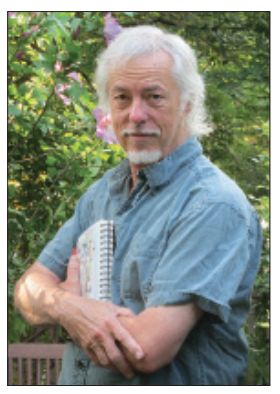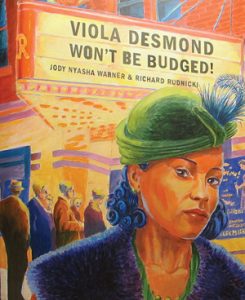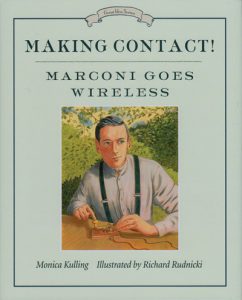Can Write: Meeting Canadian Writers and Illustrators of Children’s Books
What inspires the writers of the books your students read? How does an illustrator decide what to draw? Is it true that most authors and illustrators don’t know each other? This column features a different Canadian children’s book creator in each issue and shows you the story beyond the covers.
DREAMING OF PAINTING
Meet Canadian Illustrator Richard Rudnicki
Do you ever “ judge a book by its cover”? As a writer, I know how important the art inside and outside of the book really is, how it can add layers and depth to a story. Richard Rudnicki is a talented Canadian illustrator. I asked him about himself and his art.
Margriet: You create a wide variety of art. How do you do it?
Richard: I do studio paintings: landscapes and subjects from Canadian history. I illustrate picture books, paint figure studies and portraits.
I get to work in areas of my interest, follow my curiosity, grow with new challenges. I paint with my wife, artist and picture book illustrator, Susan Tooke. I love drawing and painting for picture books, to get into the story and tell it visually through my paintings. With thorough research, and a realistic style I develop empathy for the characters in the stories.
Margriet: Have you always been a painter?

Richard Rudnicki
Richard: I’ve been involved in art my whole life. I started in graphic design and, at twenty-five, had a successful design firm. Eventually, I left it to get back to my first love, drawing and painting. As a child, I wanted to be an artist, so this is the realization of a dream!
With so many amazing artists out there you need talent and ability, with a track record of excellence, to be a successful illustrator of picture books. You also have to market yourself: join groups, communicate, be part of the larger community. Finally, it takes luck. For me it was Susan’s work and contacts in the publishing business, and a chance meeting with an editor.
Margriet: Do you recall the importance of art in books from when you were a child? Who influenced how you now paint?
Richard: I remember the sound of my mother’s voice reading to me as a young child. I’m visually oriented, so the illustrations particularly spoke to me. I was drawn to all the illustrations I saw. I studied them carefully. Some took my breath away: N. C. Wyeth, Arthur Rackham, so many great ones. Ernest Shepard, John Tenniel. Bill Peet—astounding illustrators, cartoonists and animators. Those who both wrote and illustrated their own works especially impressed me.
Raised in Ottawa, I had access to the Art Gallery of Canada, and an excellent collection of art. I was blown away by the Group of Seven. Picasso was my hero. The Masters. However, the one who most influenced the way I now paint is Susan Tooke. She has a terrific eye, is an expert in colour and composition. We teach each other a lot, and she taught me the palette I now work with.
 Margriet: You illustrated Tecumseh—a story set in 1812—what did you do before creating these illustrations?
Margriet: You illustrated Tecumseh—a story set in 1812—what did you do before creating these illustrations?
Richard: While I enjoy the books I’ve illustrated for young children (Gracie the Public Garden’s Duck, I Spy a Bunny, Gus the Tortoise Goes for a Walk) I am especially attracted to books dealing with Canadian history. I immerse myself in research, consulting experts, museums, galleries, books. Stories like Viola Desmond Won’t be Budged and A Christmas Dollhouse took place within the last three generations, and reference material is relatively available. Making Contact! Marconi Goes Wireless took place in the latter half of the 19th century. Tecumseh’s story, however, happened over 200 years ago. The further back you look the fuzzier things become. Much of Tecumseh’s life is fairly well documented, with paintings showing details of the material culture of the time. Unfortunately, everything I found was told (often miss-told) from the white man’s perspective. To understand and render accurately, I traveled to the US and stayed with a First Nations man, an expert in all things Native, who guided and advised me. I had other experts for the depiction of the British and Americans. I acquired binders full of visual references, a shelf full of books and artifacts. All in all, researching and illustrating this book took close to two years.
Margriet: Had you heard of Viola Desmond before you did this book? What did your research entail?
 Richard: Before I illustrated Viola Desmond Won’t Be Budged, I had never heard of her and what happened to her in the mid-1940s. She was, and is, well known and highly regarded in Nova Scotia’s Black community. Members of her family are still alive. I contacted some of these people to talk about the project, to get a sense of what kind of person Viola was. I read accounts of the story, and contacted the authors. I met with them and followed up on leads. I got a lot of information that never made it into the book. I studied period fashion, architecture, cars and the material culture of the place and times. I learned a lot about the customs of the day, but also about racism. I had models pose as the main characters. It was a fascinating journey, and I love presenting this story to students and adults.
Richard: Before I illustrated Viola Desmond Won’t Be Budged, I had never heard of her and what happened to her in the mid-1940s. She was, and is, well known and highly regarded in Nova Scotia’s Black community. Members of her family are still alive. I contacted some of these people to talk about the project, to get a sense of what kind of person Viola was. I read accounts of the story, and contacted the authors. I met with them and followed up on leads. I got a lot of information that never made it into the book. I studied period fashion, architecture, cars and the material culture of the place and times. I learned a lot about the customs of the day, but also about racism. I had models pose as the main characters. It was a fascinating journey, and I love presenting this story to students and adults.
Margriet: What does an ordinary workday look like for you?
Richard: For Susan and me, this is our way of life. We work pretty much seven days a week and get as much done as we can. Almost everything we do feeds into our art. I get a lot of work done when I maintain a routine. A perfect day starts with a little writing (I wrote A Christmas Dollhouse), then painting for several hours; I end the work day with research and study. Periodically there is necessary marketing-related work to be done.
 Margriet: What would you like to share with young readers? And with the teachers who use your books?
Margriet: What would you like to share with young readers? And with the teachers who use your books?
Richard: In my talks, I emphasize that there are many ways to communicate, to tell stories, or convey messages and feelings. We are such a word-oriented culture. Many people feel that words are the only way to communicate. I want children and adults to know that the creative spirit inside us all is perhaps our species’ most valuable and accessible trait. When I present stories in books I want my audiences to understand the story as told in both words and pictures, to learn a little about the background story, the things I discovered in my research. I also want to them to know how and why I did the paintings the way I did them. I talk about the end result, but also explain the process.
To learn more about Richard and his work, visit his website: richardrudnicki.com
ABOUT THE AUTHOR
Margriet Ruurs
Margriet Ruurs is the author of 28 books for children. She conducts author presentations in schools around the country. margrietruurs.com.
This article is from Canadian Teacher Magazine’s Jan/Feb 2014 issue.












